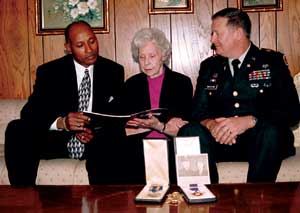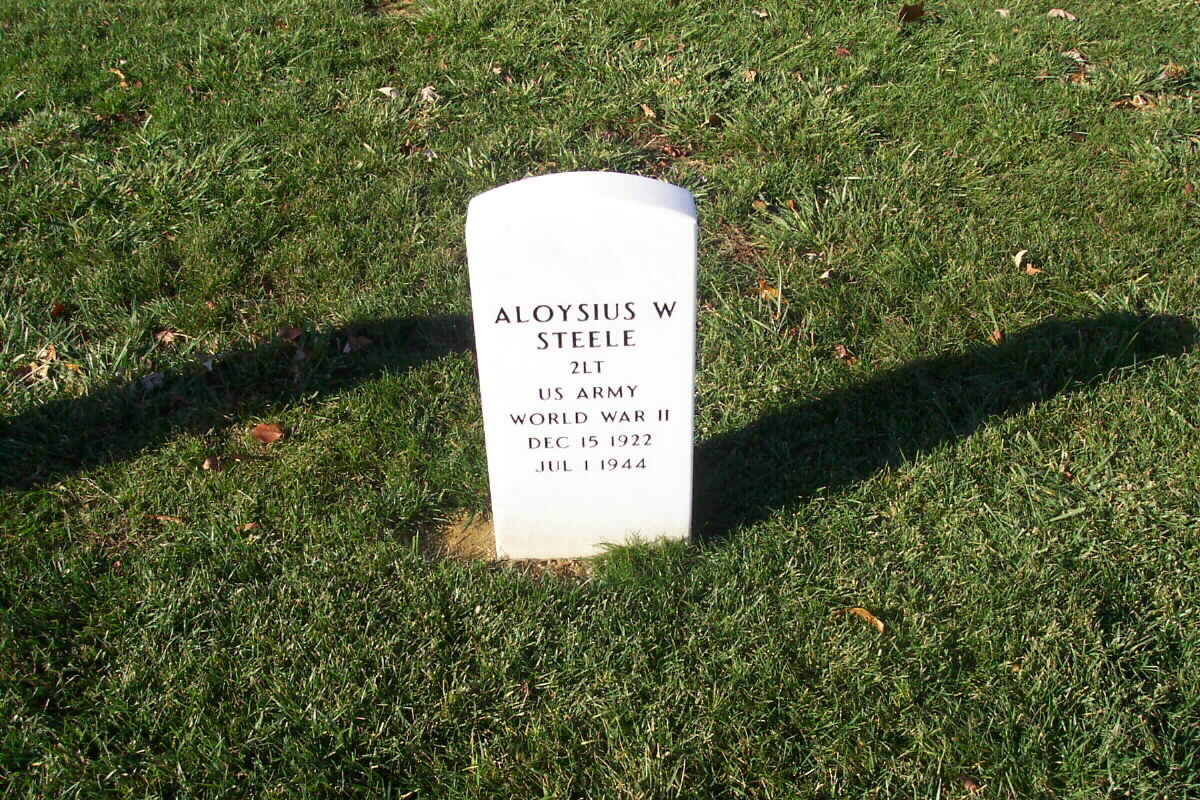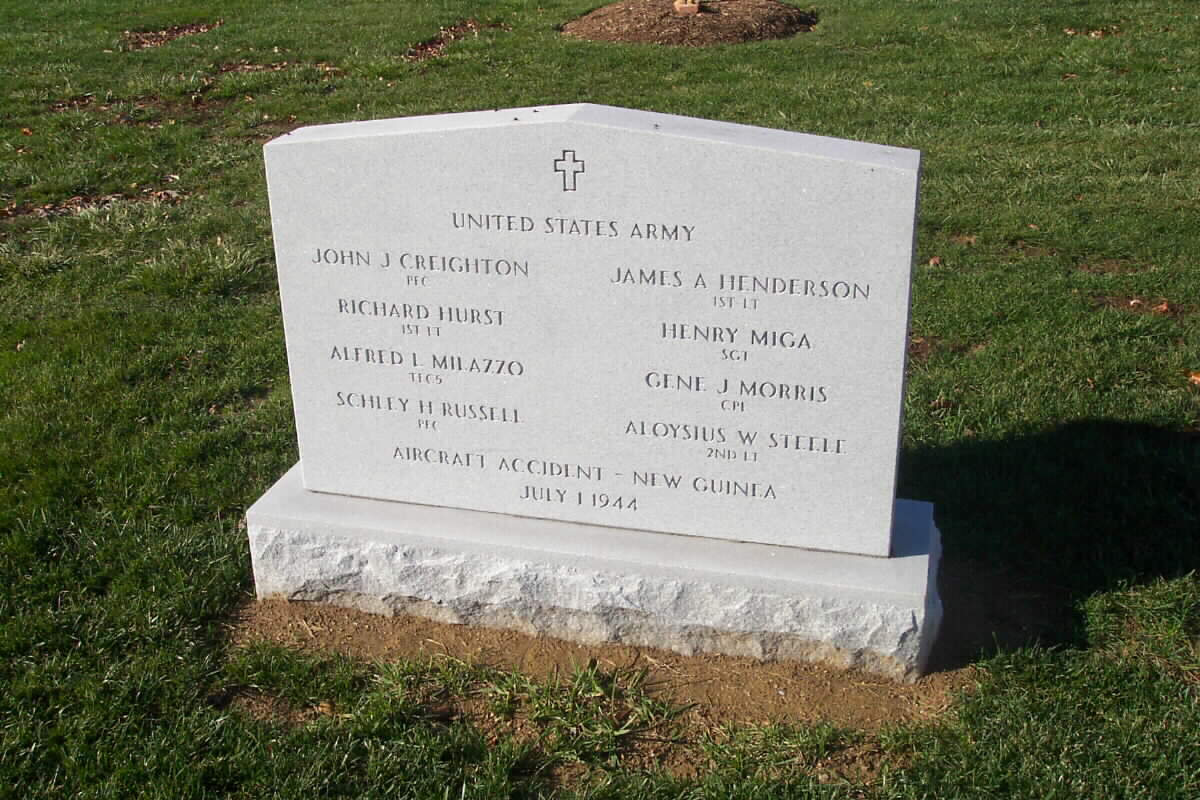Aloysius W. Steele
Second Lieutenant, U.S. Army Air Forces
0-706554
71st Bomber Squadron, 38th Bomber Group, Heavy
Entered the Service from: Virginia
Died: July 1, 1944
Missing in Action or Buried at Sea
Tablets of the Missing at Manila American Cemetery
Manila, Philippines
Awards: Air Medal
Saturday November 8, 2003
60 years later, U.S. Army identifies pilot’s remains
Elsie Garibaldi was hanging new drapes at home when she got the telephone call about her brother. It came almost 60 years later than expected.
“I let out a scream,” said the 84-year-old Vallejoan, “because (the caller) said: ‘This is the War Department. It’s about your …’
“I have a young grandson that graduated from the Naval Academy two years ago. For a moment, it was like he was killed, and I let out a screech. My stepson came flying in, and he wanted to know what was wrong. I got my composure back, but it was absolutely a horrible shock,” she said.
The call was not about her grandson, but her brother – Second Lieutenant Aloysius William Steele, who disappeared during World War II when his plane crashed in New Guinea.
Almost 60 years later, last Sunday, a U.S. Army representative informed Garibaldi that her brother’s remains have been positively identified.
Johnny Johnson, a Department of Defense specialist based in Hawaii, has been making his way across the country, meeting with relatives of the men aboard the doomed flight. Johnson and a U.S. Army major spent three hours with Garibaldi, over coffee and doughnuts, talking about the plane, the people on it, the recovery effort and how the military went about identifying the remains.
A report given to Garibaldi included photographs of the remains and the DNA used to identify the deceased. Garibaldi believes 18 people were on that plane, including another man with the last name Steele.
“The plane went down on the side of a mountain, and there it stayed for many, many years, until about four years ago when another gentleman was looking for his uncle that had gone down in the Second World War,” Garibaldi said.
Steele, who served with the 71st Squadron of the 38th Bomb Group, was born Dec. 15, 1922. His plane went down on July 2, 1945. He was missing between Saidor and Nadzab, New Guinea, Garibaldi’s son Kevin Stewart said.
“My understanding is they got shot up pretty good and went into the mountain in their bomber,” he said. “Their (24-D Liberator), from what I understand, went into the mountain and slid down. It was resting with the nose up,” he said.
Eight B-25s searched the area looking for the wreckage, he said.
“I’m glad it’s over and I’m glad they found him,” Garibaldi said.
When all the families have been notified, they will be flown at the government’s expense to Arlington National Cemetery for a burial ceremony.
“They said his uniform of that day would be laid out in the casket with his femur, which was the part that they found, and all his medals, and he would be honored (almost) exactly like the president of the United States, with full military honors,” Garibaldi said.
From what she can remember, she last saw her brother in January or February, 1943, when he was on leave. “Everything was hush-hush back in those days. He couldn’t tell where he had been or where he was from or where he was going. It’s not like today.”
Garibaldi and her brother were raised in Washington D.C. by their parents, Mary and George Steele.
She lived in Chicago and Portland before moving to Vallejo in 1965. She married Joseph Garibaldi, whose family owned land in Vallejo. Garibaldi Drive and Sala Street are named after his parents. Her husband died in March.
Stewart, Garibaldi’s oldest son, flew down from Oregon to be present for the meeting. He brought with him the Silver Star with which his uncle had been honored. Garibaldi was also given a Purple Heart for her brother, the plane’s co-pilot.
“My mother asked me to be the contact person, because she’s 84 and it’s just easier for me to do it,” he said, adding the military is putting a lot of importance on World War II.
Two or three years ago, Liz Tate, an Army representative, contacted Garibaldi and told her they’d found remains “and I would have to give DNA to make sure. I gave DNA and it came back that he was my brother.
“They had a terrible time finding me. (Tate) said she wasn’t going to give up because she knew that this young man had someone out there that was related to him,” she said.
JOHNNY JOHNSON of the Department of Defense and a U.S. Army Major
show Elsie Garibaldi the official documents that explain how her brother’s
remains were identified 60 years after his plane crashed in Papua New Guinea.
Michael Robert Patterson was born in Arlington and is the son of a former officer of the US Army. So it was no wonder that sooner or later his interests drew him to American history and especially to American military history. Many of his articles can be found on renowned portals like the New York Times, Washingtonpost or Wikipedia.
Reviewed by: Michael Howard



